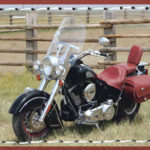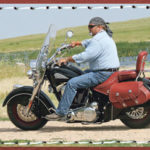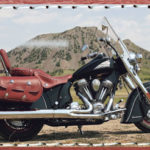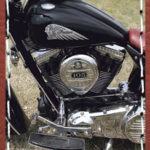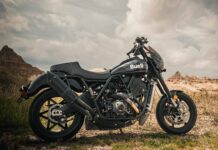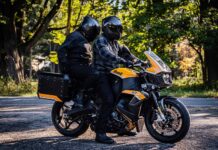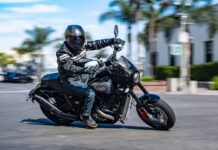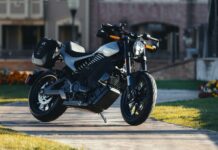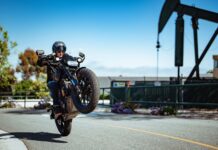Return of the native
Off the rez and into the Hills
Sturgis, S.D., August 4—It takes quite a machine to stand out in the two-wheel mobs present during the Sturgis Black Hills Rally. But while aboard Indian Motorcycle’s 2010 version of their Chief Roadmaster, the masses paused, cameras flashed and numerous questions were posed every time I took to the road. And with good reason, since this new rendition carries the traditional look of the classic models, but with a level of fit and finish that propel it above most production bikes. And although the new Indians are birthed in a wigwam located in North Carolina, the chance to chase the shadows of Big Bear Butte and follow the streams of Spearfish Canyon on an Indian Chief gave me a taste of the essence of the bike. An Indian Motorcycle in the Black Hills is just a natural.
I met with Indian Chairman Stephen Julius last year during the Sturgis Rally when the company was unveiling their new product line for the first time. Julius is the guiding hand behind London-based Stellican Limited, which bought the rights to Indian Motorcycles in 2004 following the bankruptcy of the Gilroy, California, group that had attempted to revive the marque. Stellican is a private equity firm that specializes in the acquisition of distressed companies, especially those with any type of iconic heritage, and breathing new life into them. Their successes include the Italian yacht manufacturer Riva, the Italian soccer team Vicenza and the American boat manufacturer Chris-Craft. At that time, Julius projected an initial run of 750 bikes by the end of 2009, their first full production year. But that was a year ago. And it’s been a tough 2009. But the 2010 model seems to show no compromise in quality, and no cutbacks in the caliber of craftsmanship.
The proprietary 105-cubic-inch Power Plus motor fires up easily, stoked to life by a closed loop fuel injection system supplied by Magneti Marelli attached on the left side of the bike. And while this new Power Plus outwardly resembles the motor developed during the Gilroy era, Nikasil-plated cylinders have replaced the original cast iron liners, resulting in increased durability, oil retention and greater heat transfer characteristics. The addition of MAHLE Motorsport pistons further sweetens the package. The motor is often referred to as the “bottle-cap” due to its unique rocker cover design on top of the heads, and with a bore of 3.966″ and a stroke of 4.25″, at 70 mph the V-twin lopes along at an easy 2575 rpm. While the motor performs admirably at highway speeds, it seemed anemic during hard acceleration, lacking the low-end grunt that is normally associated with an engine of that size. The company does not publish official horsepower numbers, but when I pushed for a guess-timate, they responded with a figure in the low 80s. So I can only assume there is lots of room to boost the HP. I’d start by ditching the highly restrictive exhaust. It’s an attractive 2-into-1 system but way too quiet for my taste. The top end is a little noisy, with a sound reminiscent of older Shovelheads—not objectionable, just different and something that would go completely unnoticed with that exhaust upgrade. The Baker six-speed has a ratio configuration specifically designed by the engineers at Indian to suit their requirements and is coupled to the motor via a chain-drive primary and a wet clutch with final drive train duties handled by a belt and pulley. The motor is solid-mounted to the frame, which adds a little extra vibration when kicking it up through the gears. The buzz is anything but unpleasant and I like the feel. Apparently Indian is also pleased, since they have no immediate plans to rubber-mount the engine.
The frame is a stout design with a single downtube that forks in two just above the voltage regulator. It’s a lengthy beast, sporting a wheelbase right at 68.5″, almost 5″ longer than its Milwaukee counterpart. But it’s far from unwieldy, and U-turns across two lanes without putting my feet down proved no challenge at all. Rear suspension is handled by a mono-shock located under the seat that provides almost 3″ of travel. It also provides the best Softail-style ride I’ve ever experienced. The handlebars and controls are well placed and ergonomically agreeable for my six-foot frame, although the footboards were a stretch. Both the clutch and the front brake master cylinder are Brembo products and feature a five-way, click-type adjustment to accommodate varying grip widths. The hydraulic clutch is an easy pull. Seat height comes in at a comfortable 27.25″ and is comparable to anything in its class. But what is exceptional is the seat’s comfort. I’ve been told that it’s a simple foam construction without any gel inserts or fairy dust or anything, but it is without a doubt the most comfortable stock seat on a production bike I have ever planted my skinny Texas butt on. Indian did elaborate and said that they spent a lot of time designing the shape and fitment as related to rider comfort. Whatever they did, it is a joy and I truly believe that extended travel would be a pleasure. The bike is nestled between two 16” wheels, a 130/90 up front with a 150/90 on the rear providing a stable footprint and sound stability. The model I was on featured powder-coated red rims, an option that’s also available in black or blue. Optional whitewall tires are also available. Brembo brakes are attached to 11.5” full-floating rotors and provided excellent stopping force to slow down the bike’s 747 pounds of dry weight.
But beyond the motor figures and various specs, the one shining aspect of the Indian Roadmaster is its looks. And once again I must mention that the fit and finish of this bike is superb, suggestive of Old World crafting and a care for detail. Heavily valanced fenders fore and aft reflect the marque’s history and simply shout, “Indian!” The 5.6-gallon gas tank fits perfectly with the balance of the bike, while the 41mm front end, teardrop headlight and Indian front fender running light complete the overall effect. Behind the rear cylinder and under the seat, a beautifully sculpted cowling hides the battery and some electronics. The oversized windshield is just that—oversized. Actually it’s a little too big for my taste and, when catching some of those South Dakota crosswinds, it acted like a sail. I’d prefer it about two inches shorter on top and would trim maybe an inch off each side. One nifty feature is that, while the windshield is a quick-disconnect item, it can be locked into place and secured with a key. Unfortunately, the leather saddlebags have no locks. But… they are damn big and rival any fiberglass bag on the market when it comes to cubic inches of cargo space. And the leatherwork on the seat, bags and backrest is impeccable—some of the finest I’ve seen, rivaling any one-off handmade work. The saddlebags are actually lined like an Italian handbag and feature internal zippered pockets for all those loose goodies that normally fall to the bottom and remain lost until you return home from your trip. Various colored leather options are available along with fringe and a distressed leather effect. The dash features an analog speedometer, but a huge digital readout under the speedo provides figures for total mileage, two trip odometers (great for calculating gas stops), charging amps and RPMs. A switch on the left handlebar control allows you to toggle between the readouts that even include a clock. Unfortunately the turn signals are not self-canceling, with small, perforated chrome inserts on either side of the speedo flashing green whenever a signal is engaged. And while neutral was always a simple click to find, both the neutral indicator light and the oil pressure lamp were almost totally invisible during daylight hours.
The Indian Chief Roadmaster is a beautiful bike that garners more than its share of attention. It’s not high performance or high tech but instead sells itself with classic lines, unique style and a symbolic legacy. But all that nostalgia and poignant history come at a price. The 2010 Roadmaster standard model carries the hefty tag of $33,999. So for a scant time, the Chief and I rode the Hills, chased buffalo, and escaped the cavalry. It’s good to see Indian Motorcycle resurrected from the Happy Hunting Grounds. I can only hope they survive to see many moons of success. (www.indianmotorcycle.com)


